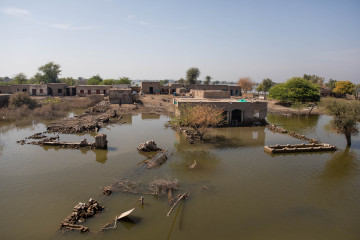

Four months after the start of record monsoon rains in Pakistan linked to climate change, the standing water has curdled into a pestilent soup breeding malaria, cholera and dengue.
The UN has warned of a "second wave" of catastrophe, with the risk that deaths from waterborne disease and malnutrition will outstrip the 1,700 drowned and electrocuted in the initial cascade.
Sindh has been the worst hit by the catastrophic flooding which put a third of Pakistan underwater, displaced eight million, destroyed or damaged two million homes, crippled 1,500 hospitals and clinics and caused an estimated $28 billion in damages.
Climate change minister Sherry Rehman said that more than 20 million people are still in need "with futures that are entirely precarious". Eight million of those require "urgent medical services," she said.
In a desperately rundown emergency clinic, a doctor treats unresponsive seven-year-old Kashaf, a suspected malaria patient lying on dirty sheets with a clutch of pharmaceuticals at her feet.
"Perhaps it's a natural disaster, or perhaps we are being tested by God, but whatever it is we are the victims," her father, 20-year-old Dildar Mastoi tells AFP.
|
Under a black scarf, his daughter's eyes have rolled back into her head. She no longer recognises her parents. Doctors say the fever has affected her brain. Barely adults themselves, her mother and father fled rising waters twice before settling in a camp where they drink from a well they suspect is contaminated by flood water.
"From early evening until dawn, throughout the whole night, the mosquitoes are overwhelming," said Kashaf's mother, 19-year-old Bashiran Mastoi. "When the night approaches we start to worry. Life at the camp is immensely miserable," she said in a vigil on her child's sickbed.
Medic Manzoor Shahani said there has been a "surge" in malaria, gastro illnesses, and dengue while "most of the patients are children and pregnant women".
Before the floods, southern Pakistan was already devastated by grinding poverty. Now aid only sporadically penetrates the patchwork swampland, while the true number of those in need has yet to even be discovered.
Doctors and officials offer contradicting figures, as they grapple to understand the scale. In Dadu, the official death toll is just 23, but everyone privately agrees the real figure must be far higher.
"This is devastation beyond the government's approach," said provincial health monitor Faheem Soomro, as young doctors tally the day's fresh patients at a boardroom table. Half of the malaria tests are coming back positive and most homes have suspected cases.
|
Sindh has recorded 208,000 cases of malaria so far this year, a dramatic rise from 2021 when cases were reported. Left untreated, as it certainly is in the stranded swathes of Sindh, malaria can quickly turn fatal.
In a normal year, there are 50,000 deaths from malaria in Pakistan. Soomro describes it as "the hidden fever". It has vague flu-like symptoms, as the mosquito-borne parasite enters the liver and bloodstream, in severe cases swelling the brain.
The healthcare disaster is most easily monitored in camps – there are 19 in Dadu – where the luckiest of the displaced live in row upon row of hundreds of simple A-frame tents. In one of the "tent cities" home to around 5,000, residents clamour for treatment in a blustery gazebo where doctors test them for malnutrition and malaria, as others offer vaccinations and female health advice.
The monsoon torrent came after Pakistan was seared by a spring heatwave, with pockets of Sindh sporadically suffering temperatures of 50C (122F).
Extreme weather events are increasing in severity as a result of climate change, scientists say. Pakistan – the world's fifth largest population – is responsible for only 0.8 percent of global greenhouse emissions but it's one of the most vulnerable to extreme weather caused by global warming.
Furthermore, the World Bank warned that between six and nine million Pakistanis are set to be dragged into poverty as a result of cataclysmic monsoon flooding linked to climate change.
Eight million people remain displaced, living in ramshackle tent cities and scattered camps near the stagnant lakes which swallowed their belongings and livelihoods.
The World Bank report said Pakistan's poverty rate is expected to rise between 2.5 and 4 percentage points as a direct consequence of the floods.
Loss of jobs, livestock, harvests, houses, and the closure of schools, as well as the spread of disease and rising food costs, threaten to put between 5.8 and 9 million in poverty, it said.
With AFP reporting




 Follow the Middle East's top stories in English at The New Arab on Google News
Follow the Middle East's top stories in English at The New Arab on Google News


